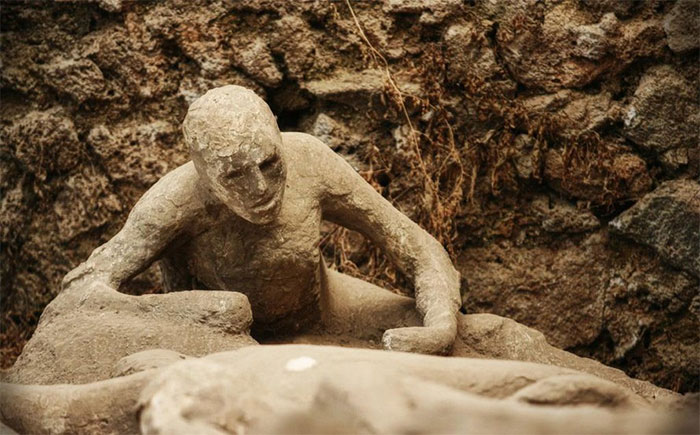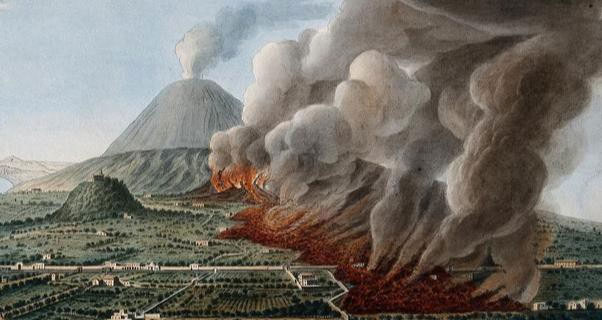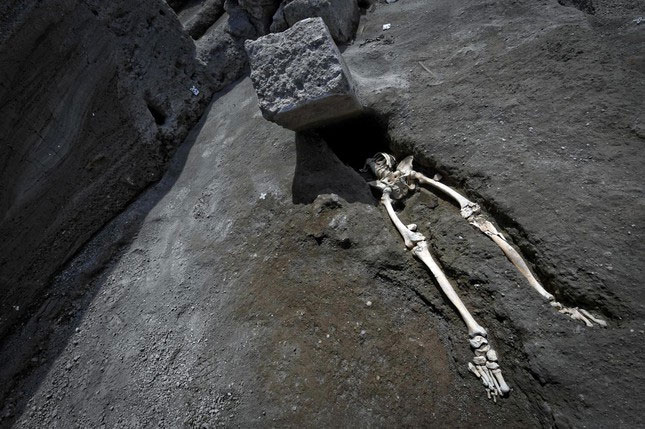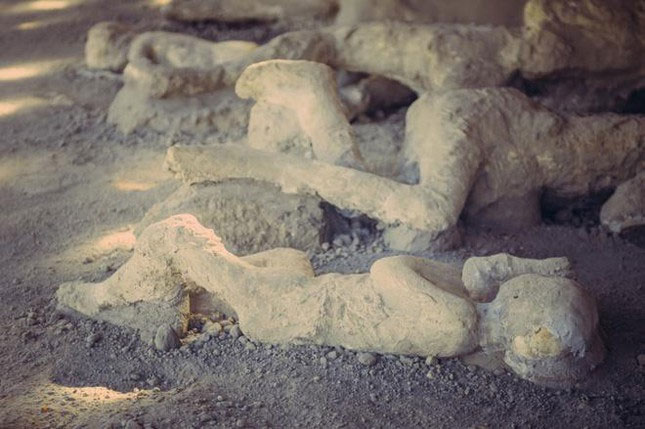The bones of a man were stained red with blood, as just seconds before, all of his flesh had completely “evaporated.”
Mount Vesuvius has experienced 8 major eruptions over the past 17,000 years. The eruption in 79 AD is one of the most famous ancient eruptions known worldwide and may have killed over 16,000 people.

Victim of the Mount Vesuvius eruption.
The ash, mud, and rocks from this eruption buried and destroyed numerous ancient Roman cities, including Pompeii, Herculaneum, Oplontis, and Stabiae, not to mention other smaller settlements that were also engulfed by hot ash.
Specifically, the city of Pompeii is famous for the layer of hot ash that formed around the victims of the eruption—those who tragically suffocated from the ash in the air, after which the dust covered them and preserved astonishing details about their clothing and faces.
Skeletons Tell Stories
Archaeologists excavating the ancient area that witnessed this horrific disaster have uncovered many stories from thousands of years ago.
Specifically, the Italian news agency ANSA reported that archaeologists discovered the skeleton of a man who died due to the eruption of Mount Vesuvius in 79 AD, providing new insights into one of the most famous volcanic eruptions in history.

Mount Vesuvius: A volcanic eruption created a deadly magma flow at the mountain’s base, 1760-1761. Color engraving by Italian artist Pietro Fabris.
According to the report, the man, believed by researchers to be around 40 to 45 years old, was killed just steps away from the sea in the ancient Roman town of Herculaneum as he attempted to escape after witnessing the violent eruption.
He was carrying a wooden box containing a ring, which may have been his most prized possession, The Times reported. It is also possible that the man was planning to propose to his girlfriend, but this sudden tragedy took away all his plans, including his life.
Archaeologists reported that the skeleton was discovered during excavations in October 2021. Upon studying the skeleton, experts remarked: “The final moments here happened instantly and were truly horrific.”
“The temperature radiating from the volcano to the town reached up to 300-400 degrees, and according to some studies, it could have been as high as 500-700 degrees Celsius. A white hot cloud raced towards the sea at a speed of 100 km/h, so dense that there was no oxygen” – researchers stated.
And the man with the ring box, after witnessing the eruption’s lava column explode into the air, was unable to escape. His bones were stained red with blood, as just seconds before, all of his flesh had completely “evaporated” due to the magma, ash, and hot gases pouring down.

Incomplete skeleton of the man. (Photo: Ciro Fusco / AP)
Pierpaolo Petrone, an anthropologist and archaeologist, stated: “They (magma, ash, and hot gases) burned away his clothes and caused his flesh to ‘evaporate.’ Death occurred immediately.“
The horror did not stop there; the man’s skull was missing. A beam from the roof had collapsed, crushing his skull, ANSA reported.
Interestingly, the skeleton was facing towards Mount Vesuvius, indicating that he had turned to face the cloud of hot gases and volcanic material in action. It is likely that this man looked back at it before he could escape like many others.
“Because most of the people (skeletons) we found in Herculaneum were looking down. Curiosity may have killed this man in a different position than the other victims,” Pierpaolo Petrone said.
Researchers are currently unclear about the man’s identity and wonder why he did not seek shelter with others. It has also been discovered that a nearby shelter contained approximately 300 different skeletons.

Plaster casts depicting victims who died while sheltering during the eruption of Mount Vesuvius. (Photo Flory / iStock / Getty)
Some experts believe he was not a wealthy man, evidenced by the ring he was wearing. The ring had a slightly reddish color, likely made of iron. And that might have been all he had of value – Archaeologist Ivan Varriale told The Times.
Thousands of years ago, Herculaneum was a coastal town favored by wealthy Romans. The ancient town is now located beneath the modern city of Ercolano in Italy.
Europe’s Only Active Volcano
Vesuvius is the only active volcano on the European mainland and has produced some of the largest eruptions in the continent’s history. Located on the western coast of Italy, it overlooks the Bay of Naples and sits within the ancient caldera of Mount Somma.
Although the last eruption of Mount Vesuvius was in 1944, it still poses a significant threat to the surrounding cities, especially the bustling metropolis of Naples, home to millions of residents.
The eruption of Vesuvius in 79 AD is why volcanologists use the term “Plinian” to describe large volcanic eruption clouds. This term is named after Pliny the Younger, a Roman historian who witnessed the eruption in 79 AD and wrote the oldest surviving description of the tree-like cloud rising above the volcano.
Modern volcanologists use this term to describe violent, large-volume eruptions that produce rapidly expanding clouds of rock, ash, and gas rising several kilometers into the atmosphere. Some more recent examples of Plinian eruptions include Mount St. Helens in 1980 and Pinatubo in 1990.


















































